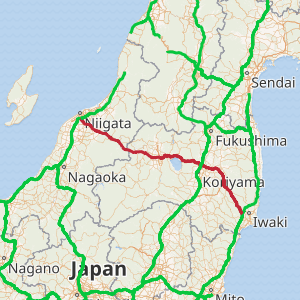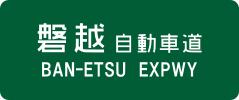Ban-etsu Expressway
The Ban-etsu Expressway (磐越自動車道, Ban'etsu Jidōsha-dō) is a national expressway in the Tōhoku region of Japan. It is owned and operated by East Nippon Expressway Company.
| |
|---|---|

| |
| Route information | |
| Length | 212.7 km[1] (132.2 mi) |
| Existed | 1990[2]–present |
| Major junctions | |
| From | Iwaki Junction in Iwaki, Fukushima |
| To | Niigata-Chūō Interchange in Niigata, Niigata Niigata Prefectural Route 16 Niigata Prefectural Route 290 |
| Location | |
| Major cities | Tamura, Kōriyama, Motomiya, Aizuwakamatsu, Agano, Gosen |
| Highway system | |
| National highways of Japan Expressways of Japan | |
Naming
The name Ban-etsu (磐越) is a kanji acronym consisting of characters found in the former names of the provinces linked by the expressway. Iwaki Province (磐城) consists of the eastern part of present-day Fukushima Prefecture, and Echigo Province (越後) consists of present-day Niigata Prefecture.
Officially the expressway is referred to as the Tōhoku-Ōdan Expressway Iwaki Niigata Route.[3]
Overview
The route of the expressway connects the coastlines of the Pacific Ocean and the Japan Sea by traversing the mountainous interior of the Tōhoku region.
The expressway commences at a junction with the Jōban Expressway in Iwaki, Fukushima and follows a northwesterly course to the city of Kōriyama, where it intersects with the Tōhoku Expressway. The expressway continues its course through the historic Aizu region, with Mount Bandai viewable to the north and Lake Inawashiro viewable to the south. The route then enters Niigata Prefecture and eventually terminates at a junction in Niigata City with the Hokuriku Expressway and Nihonkai-Tōhoku Expressway.
The route parallels the East Ban'etsu Line and West Ban'etsu Line of East Japan Railway Company and National Route 49 for much of its length.
The first section of the expressway was opened to traffic in 1990 and the entire route was completed in 1997.[2] The route was originally 2 lanes only, one in each direction. However expansion to two lanes in each direction has proceeded gradually over the years. Expansion of the eastern half (between Iwaki Junction and Kōriyama Junction) was completed in 2009.[4]
Using the Ban-etsu and Hokuriku Expressway to travel between the Tōhoku and Kinki regions is shorter and cheaper than using expressways that traverse a route via the greater Tokyo urban area.[5]
All service areas along the route feature restaurants and shops (there are also shops at Gobyakugawa Parking Area). There are 24-hour gas stations at Abukumakōgen Service Area and Bandaisan Service Area. There is a 24-hour FamilyMart convenience store at Aganogawa Service Area (Niigata-bound only). Saiso Parking Area and Miharu Parking Area feature vending machines and toilets, while all other parking areas have only toilets.[6]
List of interchanges and features
- IC - interchange, SIC - smart interchange, JCT - junction, SA - service area, PA - parking area, BS - bus stop, TN - tunnel, BR - bridge
| No. | Name | Connections | Dist. from Origin |
Dist. from Terminus |
Bus Stop | Notes | Speed Limit | Lanes | Location | |
|---|---|---|---|---|---|---|---|---|---|---|
| (16-1) | Iwaki JCT | 0.0 | 212.7 | |||||||
| 80 km/h | Four | Iwaki | Fukushima | |||||||
| TN | Gōdo Tunnel | ↓ | ↑ | Iwaki-bound 383 m Niigata-bound 373 m | ||||||
| 1 | Iwaki-Miwa IC | Pref. Route 66 (Onahama Ono Route) |
8.8 | 203.9 | ||||||
| TN | Watato Tunnel | ↓ | ↑ | Iwaki-bound 1,136 m Niigata-bound 1,131 m | ||||||
| PA | Saiso PA | 18.7 | 194.0 | |||||||
| 2 | Ono IC/JCT | 35.2 | 177.5 | ○ | Ono | |||||
| TN | Shinkazakoshi Tunnel | ↓ | ↑ | Iwaki-bound - 463 m Niigata-bound - 538 m | ||||||
| Tamura | ||||||||||
| 2-1 | Tamura SIC | 44.7 | 168.0 | ETC only | ||||||
| SA | Abukumakōgen SA | 46.8 | 165.9 | |||||||
| 3 | Funehiki-Miharu IC | 55.7 | 157.0 | |||||||
| PA | Miharu PA | 59.5 | 153.2 | |||||||
| 3-1 | Kōriyama-higashi IC | 63.7 | 149.0 | Kōriyama | ||||||
| (18-1) | Kōriyama JCT | 71.4 | 141.3 | |||||||
| BR | Gohyakugawa Bridge | ↓ | ↑ | Length - 170 m | ||||||
| Motomiya | ||||||||||
| PA | Gohyakugawa PA | 76.5 | 136.2 | Kōriyama | ||||||
| 4 | Bandaiatami IC | Pref. Route 24 (Nakanosawa Atami Route) | 79.6 | 133.1 | ||||||
| TN | Takatamahigashi Tunnel | ↓ | ↑ | Iwaki-bound 1,112 m Niigata-bound 1,122 m | ||||||
| TN | Takatamanishi Tunnel | ↓ | ↑ | Iwaki-bound 1,019 m Niigata-bound 993 m | ||||||
| TN | Shinnakayama Tunnel | ↓ | ↑ | Iwaki-bound 1,786 m Niigata-bound 1,820 m | ||||||
| TN | Kurateyama Tunnel | ↓ | ↑ | Iwaki-bound 1,648 m Niigata-bound 1,669 m | ||||||
| Inawashiro | ||||||||||
| TN | Sekito Tunnel | ↓ | ↑ | Iwaki-bound 1,443 m Niigata-bound 1,488 m | ||||||
| 5 | Inawashiro Bandaikōgen IC | 97.6 | 115.1 | |||||||
| SA | Bandaisan SA | 105.3 | 107.4 | Bandai | ||||||
| 6 | Bandai Kawahigashi IC | Pref. Route 64 (Aizuwakamatsu Urabandai Route) | 111.5 | 101.2 | Aizu- wakamatsu | |||||
| 7 | Aizuwakamatsu IC | 117.5 | 95.2 | |||||||
| 70 km/h | Two | |||||||||
| 7-1 PA |
Niitsuru PA/SIC | 124.7 | 88.0 | SIC: ETC only | Aizumisato | |||||
| TN | Nanaori Tunnel | ↓ | ↑ | Length - 2,358 m | Aizubange | |||||
| 8 | Aizubange IC | 132.4 | 80.3 | |||||||
| BR | Tadamigawa Bridge | ↓ | ↑ | Length - 310 m | ||||||
| TN | Tabanematsu Tunnel | ↓ | ↑ | Length - 1,325 m | ||||||
| Nishiaizu | ||||||||||
| TN | Toyasan Tunnel | ↓ | ↑ | Length - 2,600 m | ||||||
| TN | Nishiaizu Tunnel | ↓ | ↑ | Length - 1,018 m | ||||||
| 9/PA | Nishiaizu IC/PA | Pref. Route 16 (Kitakata Nishiaizu Route) |
143.8 | 68.9 | ○ | |||||
| TN | Nagasaka Tunnel | ↓ | ↑ | Length - 736 m | ||||||
| TN | Ryūgadake Tunnel | ↓ | ↑ | Length - 3,659 m | ||||||
| TN | Kuromoriyama Tunnel | ↓ | ↑ | Length - 2,759 m | ||||||
| Aga | Niigata | |||||||||
| TN | Koide Tunnel | ↓ | ↑ | Length - 1,121 m | ||||||
| PA | Kamikawa PA | 162.6 | 50.1 | |||||||
| 10 | Tsugawa IC | Pref. Route 89 (Tsugawa Inter Route) | 166.2 | 46.5 | ○ | |||||
| TN | Yakiyama Tunnel | ↓ | ↑ | Length - 2,997 m | ||||||
| BS | Mikawa Bus Stop | 172.8 | 39.9 | ○ | ||||||
| 11 | Mikawa IC | Pref. Route 587 (Mikawa Inter Route) | 174.0 | 38.7 | ||||||
| TN | Yoshizu Tunnel | ↓ | ↑ | Iwaki-bound 906 m Niigata-bound 952 m | ||||||
| TN | Nishiyama Tunnel | ↓ | ↑ | Length - 2,402 m | ||||||
| TN | Kumawatari Tunnel | ↓ | ↑ | Length - 157 m | ||||||
| SA | Aganogawa SA | 181.0 | 31.7 | |||||||
| TN | Komatsu Tunnel | ↓ | ↑ | Length - 200 m | Agano | |||||
| TN | Hōshusan Tunnel | ↓ | ↑ | Length - 611 m | ||||||
| 12 | Yasuda IC | Pref. Route 41 (Shirone Yasuda Route) | 188.9 | 23.8 | ○ | |||||
| 80 km/h | Four | |||||||||
| PA | Gosen PA | 191.2 | 21.5 | Gosen | ||||||
| 70 km/h | Two | |||||||||
| 13 | Niitsu IC | Pref. Route 34 (Niitsu Teishajō Route) |
198.5 | 14.2 | Akiha-ku, Niigata | |||||
| BS | Kawaguchi Bus Stop | 202.2 | 10.5 | ○ | ||||||
| 13-1 | Niitsu-nishi SIC | 204.5 | ETC only Iwaki-bound exit, Niigata-bound entrance only | |||||||
| BS | Sakaya Bus Stop | 207.5 | 5.2 | ○ | Kōnan-ku, Niigata | |||||
| PA | Niigata PA | 208.6 | 4.1 | |||||||
| 100 km/h | Four | |||||||||
| (42) | Niigata-Chūō JCT | 211.9 | 0.8 | |||||||
| 14 | Niigata-Chūō IC | Pref. Route 16 (Niigata Kameda Uchino Route) Pref. Route 290 (Sonoki Hitoichi Route) |
212.7 | 0.0 | ||||||
References
- "E-NEXCO Expressway Data". Archived from the original on 2007-12-13. Retrieved 2008-04-13.
- "Iwaki Times, October 3, 1997". Archived from the original on February 13, 2005. Retrieved 2008-04-15.
- Ministry of Land, Infrastructure and Transport. "High Standard Trunk Road Map" (PDF). Archived from the original (pdf) on September 20, 2011. Retrieved 2008-04-13.
- "E-NEXCO Opening Schedule". Retrieved 2008-04-15.
- "E-NEXCO Drive Plaza Route Search". Archived from the original on 13 April 2008. Retrieved 2008-04-15.
- "E-NEXCO Drive Plaza Service/Parking Area Search". Archived from the original on 16 April 2008. Retrieved 2008-04-15.
External links
- (in Japanese) East Nippon Expressway Company
- (in Japanese) JAF Drive Map
37°02′16″N 140°49′02″E Iwaki JCT 37°52′26″N 139°02′21″E Niigata-Chūō IC
